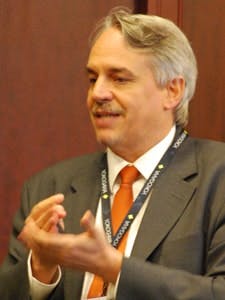Check Out Montague's Google+ profile.
Sometimes enlightenment just means a deeper understanding of what's already familiar. For example, process control applications have been so focused on performance optimization over the decades that energy consumption was sometimes an afterthought. Not anymore.Today, process engineers are seeking every means possible to rein in high energy expenses, and Yokogawa Corp. of America and its partners are coming up with some innovative and easily applied ways to help. For instance, Visual MESA energy-management software from Soteica can help users examine and analyze their energy use much more closely and find efficiencies they couldn't before, according to Oscar Santollani, Soteica's CEO.
"Everyone wants to know how to leverage their existing infrastructure to assist operators and shift supervisors in reducing energy costs 24/7/365 within emissions constraints; solve their energy and carbon balances; and give their organization validated and consistent energy and emissions key performance indicators (KPIs)," said Santollani, who presented "Improving Energy Performance: Industrial Case Studies of Monitoring and Optimization" today at the 2014 Yokogawa Users Conference and Exhibition in Houston.
Start with First Principles
"You're bringing real, money-generating KPIs to the control room, and aligning operations with your company's profit and loss statement." Soteica's Oscar Santollani on the ability of his company's Visual MESA software to help process manufacturers reduce energy costs and improve the bottom line.
Because they're process control engineers, many users want to apply the same procedures to energy that they do to their regular applications. "They want to make the principles of process engineering seamlessly available through a rigorous, site-wide, real-time energy and emissions mathematical model like Visual MESA," said Santollani. "These principles consist of plant-wide mass and energy balances, including interactions among all energy subsystems, such as steam, boiler feed water, condensate, fuels, power, hydrogen, chilled water, etc. They also include first principles-based equipment models and thermodynamic calculations, as well as theoretical combustion calculations. These can all help improve optimization and economics. It's becoming extremely important for users to think about how entropy may affect economics."Santollani added, "By applying rigorous first principles, such as mass and energy balance, you're ensuring sound engineering calculations as well as consistency. By including economics in the rigorous model, you're bringing real, money-generating KPIs to the control room and aligning operations with your company's profit and loss statement. And by including optimization in addition to simulation, you're fulfilling the true purpose of your decision-support systems."
However, before Visual MESA and other helpful energy-analysis software can be successfully deployed, Santollani added, they must pass the "reasonable operator's test." The software has to be able to run unattended and achieve typical uptimes of greater than 90% in both open-loop and closed-loop where applicable. "Also, it has to be measurement driven, but at the same time able to adapt to faulty measurements on the fly. Finally, the model must be able to be maintained over time."
Santollani reported that Visual MESA gives users several primary capabilities for improving energy performance, including utilities optimization, energy management KPI calculations, monitoring, auditing and accounting. He added that BP Ligen's facility recently implemented Visual MESA, which produced operational recommendations that added up to 2 to 4% of its energy costs.
"Utilities systems models can deliver a financial gain by reducing the impact of exceptions," said Santollani. "Having all the information of your site-wide utility systems, as well your equipment limits, your emission limits, your reliability constraints and your contracts in one model brings immediate value, and can serve up validated and consistent energy and emissions KPIs to the entire organization. Utilities have always been the ugly duckling of process control because no one really wanted to look at them. But they're a lot more attractive now because users can make some real gains and money by addressing them."








